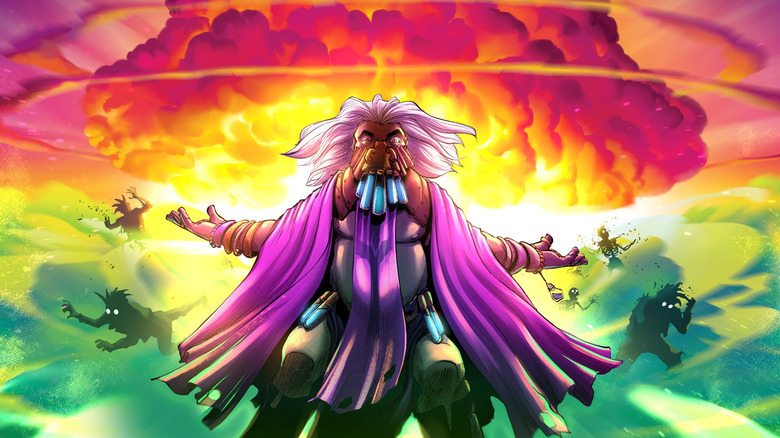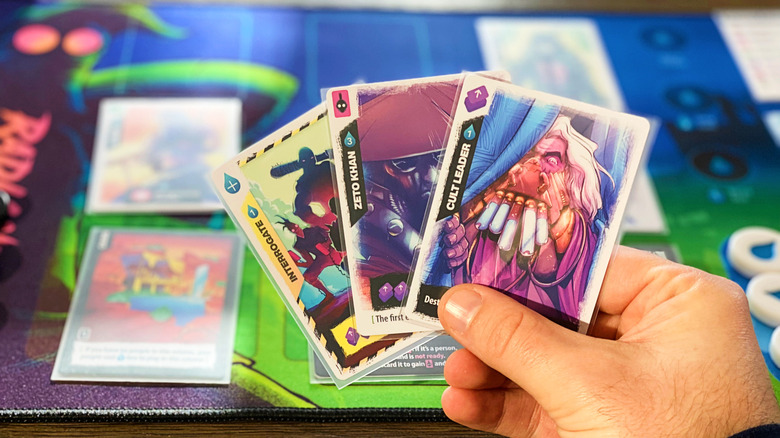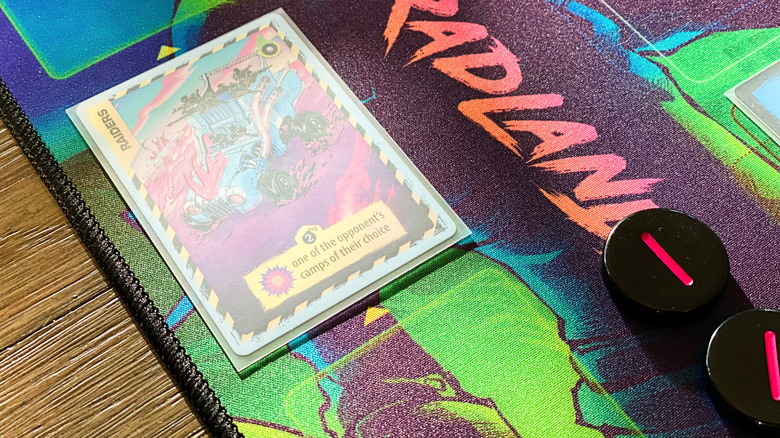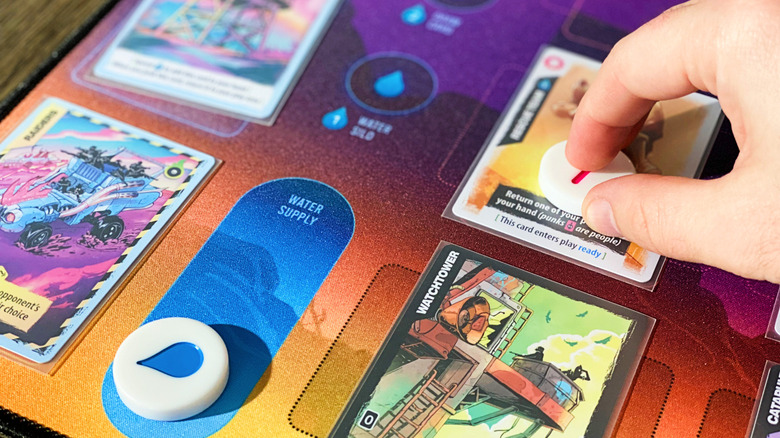Radlands Is The Colorful, Mad Max-Inspired Card Game You've Been Waiting For
(Welcome to Cardboard Cinema, an ongoing series where we look at the board games inspired by or connected to our favorite media. In this edition: a post-apocalyptic card game in the vein of "Mad Max: Fury Road.")
As someone whose love of board games is rooted in cinema, I am grateful that the murky color palettes of Hollywood do not always find their way onto my tabletop. I love post-apocalyptic narratives, but even I grow tired of the blacks, browns, and brownish-blacks of modern favorites like "The Road." So when I saw the neon artwork of Daniel Piechnick's debut game, I knew that I wanted to add "Radlands" to my board game collection.
"Radlands" is a lane-battling game, where two players choose three base camps — each with unique abilities — and purchase characters to protect their camps or attack their enemy. The game's currency is water; each turn, players will draw three water tokens and use them to play new characters, activate abilities, or trigger time-based events. As part of their board, players can also purchase the Raiders card or the Water Silo, which attacks enemy camps or gives you a future water token (respectively). Players draw cards from a shared deck and take turns until all three camps on one side have been obliterated.
Like summoning sickness in "Magic: The Gathering" — a game that Piechnick once played professionally — characters enter play in "Radlands" needing to wait a turn before they can be activated. Similarly, the events deck in the game uses bomb icons to determine their place in the events queue, often taking two or even three turns to come into effect. This makes "Radlands," like "Magic," a game of strategic delays. You may have an excellent combination of cards in hand, but your opponent will always get a chance at rebuttal before you use them.
Manage Your Resources
But unlike "Magic," the hard cap on resources in "Radlands" affords the game a strategy all its own. Rather than shy away from overpowered cards, "Radlands" unapologetically leans into game-breaking abilities. If players can afford the water cost of one of the game's many heroes, they unlock potent abilities. You can play events instantly with Zeto Khan or — hilariously — even destroy one camp a turn with Molgur Stang. These cards demand players to be nimble in their card usage, making it impossible to plan too far ahead without accounting for your opponent.
The result is a game that somehow — wondrously — manages to be both swingy and balanced. Several times in my games, I saw a clear path to victory, only to have it thwarted when my opponent switched gears to play defensive. I have emptied an enemy lane — presenting a clear shot on their final camp for my soldiers — only to have my opponent injure my only characters with the damage action. Or I have flooded the board with people and then shouted in dismay as my opponent revealed the game-changing Truce card — forcing me to return every person to my hand.
And since every player is operating on the same two-turn delay — one turn to play your cards, another turn to use them — the desire to sell out offensively is constantly undercut by the need to play defensive. Say you have a damaged camp: do you junk your Sniper for the repair action to help it survive another round? Do you attack your opponent's camp and hope they'll play defensively? Or do you sacrifice your camp and enjoy a two-to-one attack on the enemy? As the game progresses and the number of camps dwindles, the impulse to go all-in on victory becomes hard to ignore.
Raid the Enemy Camps
And that's just juggling the actions and the water supply. A few games into "Radlands," it becomes painfully clear that managing your deck will also be a challenge. Although you get to draw one card at the start of your turn, any subsequent cards require either a character action or two water tokens (a veritable fortune in this game). The end is never sudden, but you can feel it around the corner when you're hemorrhaging water in the final few rounds to frantically cycle through your draw deck.
The truth is, "Radlands" would be a fun game with any theme, but the color palette of "Radlands" also makes it a welcome departure from the muted tones of so many other post-apocalyptic board games. "Mad Max: Fury Road" is an obvious cultural touchpoint; the Cult Leader, a character who can sacrifice his men to damage the opponent, mirrors the wild white hair and prodigious respirator of Immortan Joe. But the artwork from graphic designers Manny Trembley, Damien Mammoliti, and Mr. Cuddington is rooted in vibrant colors found across the genre.
This apocalypse is a feast for the eyes, and the various characters that inhabit it — from bionic soldiers to street gangs with a passing resemblance to Guy Fawkes – are woven together with neon purples and greens. And just like with any good card game, the combination of pleasing design and sound strategy can make several cards stand out. I am particularly partial to the Rescue Team, a person who allows you to return characters to your deck at zero cost. Pair them with a Mutant — who does (and takes) damage on play — and I can craft a delightful nightmare on a loop for my opponent.
Hoard Your Supplies
But the true wonder of 'Radlands' — the thing that has made it a must-play among my group of friends — is the fact that it is a genuine standalone game. Roxley Games has been explicit in their lack of desire to make expansions for "Radlands." With players drafting or choosing from among 34 different camps, there is more than enough variation in the gameplay to keep sessions fresh indefinitely. This approach provides all the fun of a customizable card game without the expansive rulebooks or expensive add-ons. Once I've taught someone to play, they have all the knowledge they'll need forever, and I am not dooming them to an eternity of purchasing more cards to a game increasingly too complex to play.
You probably could not design a more perfect card game for me if you tried — one that promises explosive moments of gameplay, anchors its strategy in scarcity, and themes the entire thing in the best neon apocalypse this side of "Radioactive Dreams." It may not be for everyone — no board game is — but it makes 'Radlands' my unicorn game, something as fun as it is stylized. God forbid someone ever turn this into an app. I may never get another day's work done again.



